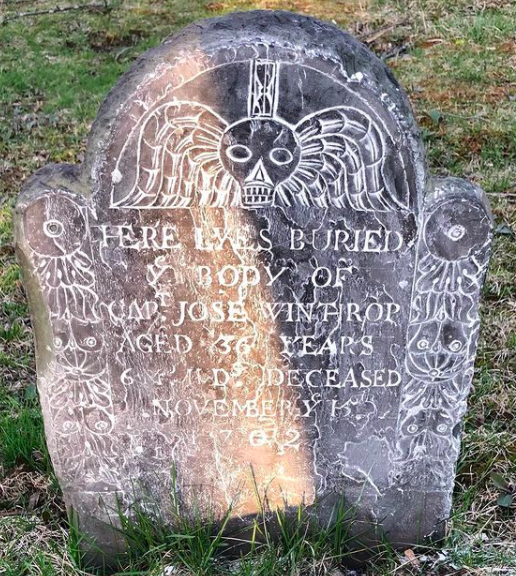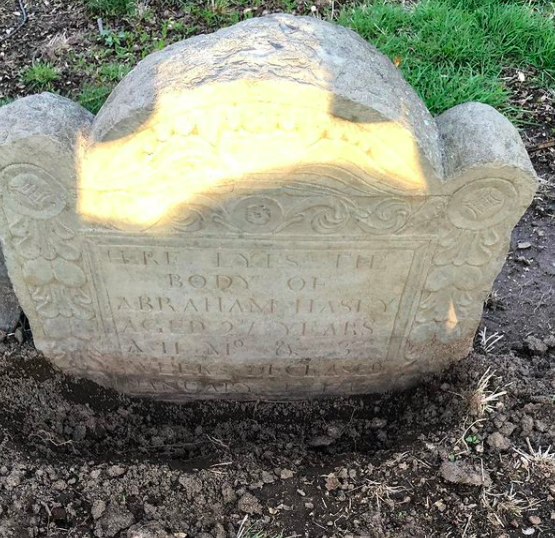It’s frustrating, when you visit a cemetery or burial ground to look at a few specific headstones only to find them covered in lichen, moss, or other discolourations from processes like acid rain. Maybe the stone you are interested in are sunken a little, and those crucial last few lines are obscured by the soil. It may be tempting to try to clean the lichen or staining off the stone, or scrape away at the ground, but we’d love for you to stop there! Without the proper equipment, knowledge, and the vital permissions, you might be doing more harm than good. In this post, we’d like to talk about some examples of damage done by well-meaning folks in cemeteries that has come up on social media in the last week, in an ongoing discourse on how to safely clean gravestones.
Wire Brushes

This one comes up a lot! Wire brushes or wire wool is really useful in the kitchen for scrubbing those baked on goodies off your dishes, or cleaning the racks of a BBQ, but should definitely not be used on a gravestone!
A few days ago, Kate of @BurialsBeyond on Twitter, posted this photo (left) as part of an ongoing conversation that sprung up regarding damage caused by poor cleaning of gravestones. The image shows a gabled cross chest tomb, with white scratch marks over the inscription on the sides. This damage was done with a wire brush/wool, by an individual trying to remove lichen from the stone to make the lettering more legible.
Unfortunately, while removing the lichen, the tough metal also removes particles of the stone itself. Pieces of stone are scraped away from the surface, as the metal is harder than the stone. This is something that cannot be reverse, and will speed up the weathering process of the monument. Never use metal on a gravestone for any reason.
Chalk & Other Powders
It used to be common place to advise people to use powders such as flour, baby powder, or chalk dust to highlight the inscriptions on an otherwise weathered gravestone. Today, we know that it can actually be damaging to the gravestone to use these materials!
Today, the wonderful Rumney Marsh Burial Ground (@rumney_marsh_burial_ground on Instagram & @rumneymarshBGRC on Twitter) posted that they “went to lock up the burial ground yesterday and was distressed to see that someone had chalked a number of gravestones in order to read them more clearly“. While these make very striking photos, the chalk particles actually get inside the stone. This is the same for any other powders (also shaving cream, etc), and when they get wet they expand within the stone, actually breaking the face of the gravestone from within. This is irreversible. Even when the stones are cleaned, material is stuck within the face of the stone. While stones appear solid, they are susceptible to all kinds of damage. The best course of action is to use a flashlight or mirror to direct light onto hard to read areas. Our goal is to Do No Harm!

Sale gravestone at the Rumney Marsh Burial Ground (Photo from the Rumney Marsh Instagram, April 20, 2021) 
Winthrop gravestone at the Rumney Marsh Burial Ground (Photo from the Rumney Marsh Instagram, April 20, 2021)
Digging in front of Gravestones

As time passes, sediment builds up, as it is carried by the wind, or created by debris or organic materials decomposing. This process, combined with the gravestones themselves slowly sinking under their own weight, results in the base of some gravestones being obscured from view. This, unfortunately, includes the last few lines of text in many cases…and the date! Even though this is the case, it is never alright for someone to dig into the ground in front of a gravestone in order to expose the sunken portion of the inscription. There are several reasons why!
Firstly, unless you have express permission and the correct permits, it is illegal to conduct ground disturbance (ie digging) in an active or historic cemetery. In some places, historic, abandoned burial sites are protected under archaeology laws, and require an archaeological permit. You should never dig in a cemetery without express permission from the managing party, even if a permit is not required. Additionally, a cemetery houses human remains. You do not know what is below the surface, and any digging could disturb remains.
Secondly, it’s dangerous! Especially for historic stones, you do not know the state of their stability. Removing the soil from the base of the stone could case it to fall forward and break, after losing a portion of its support. Additionally, if the soil was supporting the stone and is removed, the stone could fall onto you or others nearby. These gravestones are extremely heavy, and can seriously injure or even kill someone if they fall. Please leave the gravestones as they are, and check local records or online resources like Find A Grave or Billion Graves to search for full inscription records, rather than potentially damaging the stone or yourself.
Conclusions
As always, in gravestone conservation, surveying, and recording, we want to follow a Do No Harm practice. Never use anything to clean a stone or highlight the text that could deposit anything like salts, acids, or powders into the stone. We also don’t want to use anything for cleaning the inscriptions that are harder than the material itself, like metal! The damage these tools do is irreversible, and we need to spread that information as far as possible. Likewise, digging at a cemetery shouldn’t be undertaken by members of the public, for their safety and the safety of the stones.
The best practice for any gravestone conservation or recording is to make sure you are armed with the most up-to-date knowledge for what you are hoping to do, and to never undertake any cleaning at the cemetery without express permission of the managing party, and the family if the stone is more recent! As always, if you have questions about gravestone conservation or are interested in working with us, send us an email or message!
Thanks for reading!
2 thoughts on “Illegible Gravestones & Cleaning Damage: Wire, Chalk, & Shovels”